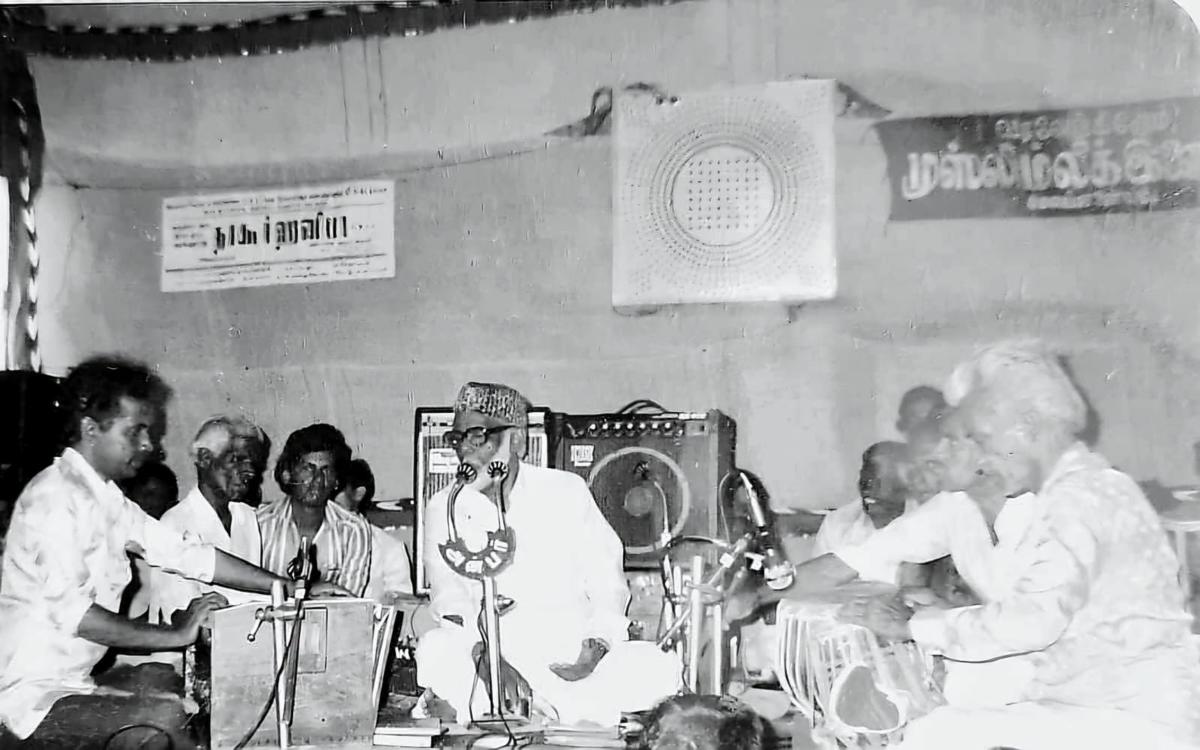Of the many singers in South India with a universal appeal, ‘Isai Murasu’ Esmail Mohamed Hanifa stands tall on the pantheon of greats with origins in Tamil Nadu’s Cauvery delta region.
Hanifa, an iconic minstrel of Islamic devotional songs in Tamil had strong links with Nagore, the town in Nagapattinam that hosts the 16th century shrine to Sufi saint Syed Abdul Qadir. It eventually became the prefix to his name too.
Recently, the Tamil Nadu government kickstarted the celebration of Hanifa’s centenary year by naming a street and public children’s park in Nagore after him.
It is a fitting tribute to a man who captured the hearts of fans with his distinctive baritone from the early 1930s.
Even posthumously, the Hanifa fan base continues to grow, as seen by the number of cover versions of his ‘Iraivanidam Kaiyenthungal’ and his other songs that are available online.
Hanifa’s devotional and wedding songs continue to hold sway in Tamil Muslim social functions
| Photo Credit:
Special Arrangement
The youngest of three children of Mohamed Ismail, a railway worker in Malaysia, and Mariam Biwi of Ramanathapuram, Hanifa began singing mainly to support his family.
The singer spent his early childhood in Ramanathapuram, and later went to work for his paternal uncle Abu Bakr Rowther in Tiruvarur. It was here that Hanifa’s musical talent was noticed. His first professional concert at the age of 13 set him off on a trajectory no one imagined.
“My father’s rousing voice owes much to the Ghousia Bait-us-Sabha at Nagore, for whom he used to sing,” says his son Naushad Ali, based out of Chennai.
“At the time, there was a practice of taking out a pre-wedding procession to introduce the bridegroom to the families in the neighbourhood. A team of young drummers beating ‘thabs’ would head the procession, followed by the groom in a car or on horseback. My father and his accompanists would be in the middle, with the hosts and guests making up the back of the crowd. He learned early on to beat the competition from the ‘thabs’ boys by singing loudly and in tune, without the help of a microphone. It was a skill that he developed out of necessity,” he adds.

Hanifa was a mainstay at most of the ‘Urs’ festivals held by the Sufi dargahs in the State
| Photo Credit:
Special Arrangement
Naushad, now in his sixties, was his father’s caregiver in his later years, and also renders vocal concerts in the Nagore Hanifa style.
Hanifa’s devotional and wedding songs continue to hold sway in Tamil Muslim social functions. His devotional songs were often based on ‘nasheed’ (Islamic chants sung a cappella or with instruments) and ‘naat’ (poetry in praise of Prophet Muhammad), referencing the Muslim faith, history, and current events. Quite a few of them were modified to suit Tamil listeners.
‘Hasbi rabbi jallalah’, for instance, has just the first stanza in Arabic; the rest of the song in Tamil adds elements from Ramanathapuram’s history. “It was first recorded in the 1970s for a school function, and I was among the children who sang the chorus,” recalls Naushad.
‘Maalai soodum manamakkale’, ‘Vazhga, vazhga, vaazhgave’ and ‘Deen kula kanne’, were among the songs that he presented at marriage concerts, usually held a day before the nuptials or after the wedding reception.
He was a mainstay at most of the ‘Urs’ festivals held by the Sufi dargahs in the State.
Nagore Hanifa married past the age of 30, and his wife A.R. Roshan Begum looked after the couple’s six children in Nagore while Hanifa built his career.
“We did not get to see our father much while growing up, because he would always be on tour. At the peak of his career, he would have at least 45 engagements in a month. He rarely declined any offer. Those were different times, with no marketing, public relations or copyright. Many songs were set to popular film tunes re-arranged by his small orchestra. I wonder how he managed his career all alone,” wonders Naushad.
Hanifa’s songs were known for their profound lyrics. He was helped in this by poets Abidin and Nagore Saleem, among others.
The self-taught maestro picked up tips on Carnatic music from S.M.A. Qadir at the Nagore dargah.
Naushad was tasked with the job of copying out the lyrics and taking care of his father’s correspondence. “Much of what I know about Tamil literary expression and pronunciation is due to my father. He would rap me on my head if I got the spelling or grammar wrong,” he laughs.
Though he had a prodigious memory for lyrics, Hanifa would always take his notebooks with him on stage. “If he noticed mistakes in the rendition, he would skillfully re-sing the portion in a way that the audience would not notice,” shares Naushad.
Nagore Hanifa performed in all kinds of venues — from five star hotels and modest homes — with the same flair, and never let his celebrity status get in the way. He would also do any number of encores — he had no ego, says his son.
Hanifa occasionally lent his voice to Tamil films — in movies such as Gulebakavali (1955), Paava mannippu (1965) and Chembaruthi (1992) — but consciously kept away from cinema because he was not open to adopting a ubiquitous name such as ‘Kumar’, which was what some composers demanded.
“My father used to say that it is more satisfying to sing four songs as Hanifa than a crore songs as Kumar. Having held the stage in live concerts that ran into hours, he did not appreciate his craft being adapted for light music,” says Naushad.
When Hanifa passed away on April 8, 2015, at the age of 96, a veil fell forever on an era of homespun superstars produced in Tamil Nadu.
Political anthem
In his heyday, Hanifa used to be known as the ‘voice’ of the Dravida Munnetra Kazhagam (DMK), because of his political anthems for the party. His warm friendship with DMK leader and former Chief Minister M. Karunanidhi began in their adolescence and stayed strong through their lifetime. Some of the songs he sang for the party are still used by the DMK to raise the morale of party cadres.
Published – February 03, 2025 01:13 pm IST
www.thehindu.com (Article Sourced Website)
#minstrel #Nagore
